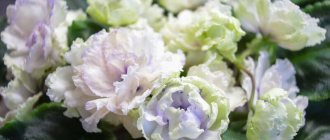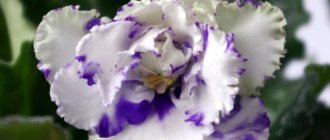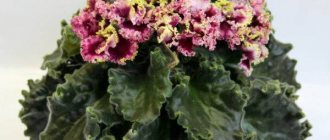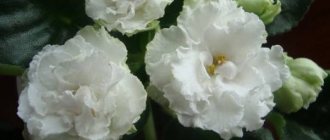The delicate and unpretentious Uzambara violet, having appeared at European flower exhibitions at the end of the 19th century, instantly attracted the attention of flower growers and gave rise to the undying interest of breeders of the Old and New Worlds in transforming its varietal qualities.
Over the years, a huge number of varieties and hybrids of the original tropical plant , and American breeders played a significant role in this.
In the middle of the last century , violet appeared in the collections of Soviet flower growers; domestic amateur violet growers actively participated in the process of its cultivation and made an invaluable contribution to improving the decorative appearance of the charming African guest.
The varieties of violets bred all over the world are conventionally divided into classic ones, found in most gardeners ’ collections, and new ones, recently introduced for sale and in particular demand.
The number of new products is constantly increasing, and previous popular varieties are becoming classics.
At the same time, good-quality classic varieties of violets gradually lose their relevance , being preserved only by the keepers of the variety and its true connoisseurs, and become retro varieties.
They may not be inferior to new products in terms of varietal characteristics and decorativeness, but they are not fashionable breeding objects.
Next, we will show you retro varieties with names and photos of domestic and foreign selection, which are still deservedly popular among violet growers.
Retro varieties of violets
According to an unspoken rule, all varieties of foreign selection obtained in the last century are completely conditionally classified as retro varieties.
IMPORTANT! Domestic varietal violets are classified as retro if they were bred before 1990. Starting from this border, for inexplicable reasons, violets acquire a decorative appearance and a modern perception that differs from retro varieties.
In the Soviet Union, Saintpaulia first appeared in Leningrad - in the Botanical Garden associated with the State University. The first specimens of violets were brought there and its director D.M. Zalessky . The breeding developments of this specialist include the magnificent varieties “Blue Danube” and “Light and Shadow”.
Boris Mikhailovich Makuni , who devoted forty years of his life to delicate violets and created more than 300 of their varieties, is unconditionally recognized as a luminary in the domestic selection of Saintpaulia In order not to divide the breeding line of the Makuni spouses (Boris Mikhailovich worked on varieties together with his wife Tatyana Nikolaevna), who created new Saintpaulias until 2002, all their varieties are considered a retro category.
Boris and Tatyana Makuni.
At the same time as the Master, many domestic breeding enthusiasts worked on the decorative appearance of violets. All of their varieties, created from the late 60s to 19990 and preserved in the collections of flower growers, belong to retro violets.
The reasons for this name
In Soviet times, only passionate non-professional flower growers . They did not know how to keep records and describe the varieties obtained, and did not think about creating catalogs and classifiers.
In this regard , many developments disappeared without a trace, and varieties were preserved in minimal quantities . It is for this reason that their violets are classified as retro.
ATTENTION! In addition, all antiques, household items and decorations that rarely appear in everyday life and carry some historical or material value fall under the term “retro”. This category also includes violet varieties bred from the last century.
Caring for a plant at home
Both varieties, despite some peculiarities in appearance, do not require special care , performing well if the minimum rules for caring for Saintpaulia are observed.
Conditions of detention
Considering the variegation of one of the varieties, there are some special recommendations for choosing a place for its cultivation:
- Lighting – LE-Greenland prefers partial shade and even shade; RS-Greenland is more light-loving. The first, under such conditions, increases the amount of light on the leaf. It is necessary to pay special attention to this issue in winter, when light comes not only from the sun, but is also reflected from the snow, because such lighting is also considered and can even cause burns to the sheets;
- It is recommended to maintain an average temperature all year round, within 22-24° C. If the regime is changed seasonally, then the winter minimum is 16, and the summer maximum is 26. In the off-season, it is important to smoothly transfer the plant to a new regime;
- Humidity – Saintpaulia prefers 60-70%, but if this is not possible, then this is not critical. If the humidity is fixed, it is recommended to change it depending on the temperature in the room - the warmer it is, the more moisture the flower needs and vice versa.
Watering and fertilizing
Both Greenland varieties respond well to different types of watering :
- Classical – into a tray or under the leaves (avoiding contact with the leaves and growing point). The procedure is carried out as needed, when the earthen clod dries out, about once a week, at a temperature of 25°. For this type of irrigation, fertilizing is carried out through irrigation (about once every 2 weeks), and the dosage of mineral fertilizer is reduced by half, relative to that stated by the manufacturer;
Saintpaulias are often watered using a wick. - Wick - water is in a container under the pot, and the plant draws it through the wick, lowered by the bottom drainage hole. In this option, water is constantly in the container and fertilizer as well. The concentration of mineral fertilizer is reduced by 7-8 times relative to that declared by the manufacturer.
Pruning, replanting, rejuvenation
These varieties do not require frequent replanting, both during growth and after. Typically, the procedure is carried out once a year - for an adult plant and, as necessary, for a growing rosette. Depending on the purpose of the transplant, it is carried out in two ways :
- Transshipment - for a growing individual, in order to enlarge the pot. To do this, prepare a new pot, a little larger than the old one, a substrate and the plant itself. Next, simply transfer the rosette, along with the old soil, into a new pot and sprinkle it in a circle with new soil;
- Replanting, with soil replacement - during a planned replanting, or in case of illness. The tools are the same as for the first option. Saintpaulia is taken out from the flowerpot, all soil is shaken off, damaged roots are removed, and the lower leaves are cut off.
During planting, the stem is buried, placed strictly in the center and covered with soil, avoiding contact with the leaves.
Often, the method of replanting with soil replacement is used for rejuvenation, in which several rows of leaves are cut and, if necessary, the stem is cut from below to the level of living roots.
Attention! For hygiene purposes, faded leaves and peduncles are trimmed as necessary, otherwise they draw juice from the outlet and spoil the appearance.
For planting and replanting Saintpaulias, it is important to use suitable soil ; you can buy it in a store or make it at home. The substrate is made up of equal parts of peat, soil and perlite, and one-third of sphagnum moss is also added (for wick irrigation, only peat and perlite are used in equal parts).
Reproduction
Most often, violets are propagated by leaves.
Like all Saintpaulias, propagation is carried out vegetatively (to obtain new varieties - by seeds):
- Leaf cuttings - use material from the second or third row. Rooting is carried out in water, soil or moss. After the babies appear and grow to 4-6 leaves, after which they are seated;
- Stepchildren - stepchildren are planted with their own roots, or if there are 4-6 leaves, they are rooted like a leaf cutting;
- Peduncles - they are rooted in the soil under the film (they are rarely used, there is a possibility that the children will not have variegation).
Top varieties of domestic and foreign selection
Domestic selection
In the second half of the 20th century, a whole galaxy of passionate flower growers and self-taught breeders worked on the creation of new varieties of Saintpaulia.
Their names are unknown to a wide circle of violet lovers, but without their dedicated work, the emergence of new modern varieties of this marvelous plant would be difficult. Among them are:
- D.M. Zalessky;
- Makuni spouses;
- V.N. Kolesova;
- S.A. Aksyonova;
- L.V. Radin;
- V.A. Mikheeva;
- I.D. Lowbrow;
- S.I. Prilutskaya and many, many others.
“Beloved Daughter” (B.M. Makuni)
Saintpaulia type standard . Above a dense rosette of slightly wavy leaf blades of a dark green shade, a cloud of lavender color is formed from large corollas of simple fullness.
The petals have a wavy outline outlined in dark purple.
The peculiarity of the violet is the lightening of the color of its flowers as they open.
“Sweetie” (B.M. Makuni)
“Sweetie” is a representative of the Pink Series. Violet standard type.
The rosette with a neat outline consists of leathery, slightly long leaves of a dark tone with a marsh tint. The edge of the sheet is wavy, the reverse side is illuminated in red.
Flowering is cap, almost all year round. The corollas are pink carnations with a greenish fringe on each petal.
“Lilac Fog” (B.M. Makuni)
Standard type. Violet leaves of a dark shade with a rounded-toothed edge form a symmetrical rosette of dense fullness.
The voluminous cap is formed from wavy-corrugated terry-type corollas, colored with transitions of different tones of lilac.
The peculiarity is a very long period of preparation for flowering.
“Solveig’s Song” (B.M. Makuni)
"Solveig's Song" represents the author's Blue Series, being the best in the line . Standard.
An evenly filled, compact rosette is formed by rounded leaves the color of summer grass. Strong flower stalks support magnificent large corollas of a semi-double appearance with a wave along the edges of the petals.
Coloring - shimmering blue tones.
“Blue Danube” (D.M. Zalessky)
One of the first varieties of domestic selection. Standard type.
The neat rosette consists of rounded-toothed leaves with wavy edges, painted in the tone of dark green with an emerald vein. Corollas of simple fullness with a slightly wavy outline.
The buds are painted in a delicate tone of bluish-lilac color.
“Orchid” (V.A. Mikheev)
Based on the type of flower color, Saintpaulia is classified as a two-color violet.
The leaves are greenish-marsh in color with lighter veining and have a rounded shape with a slight point.
The simple-looking corollas are painted with shimmering lilac colors. Along the contour of the flower there is a white edging, turning into a clear pattern on the upper petals.
“Mazepa” (L.V. Radina)
The violet has a somewhat loose rosette due to the elongated leaf petioles. The leaf blades are rounded and light green in color.
The corollas are large in size, terry full.
The peculiarity of the violet is the change in the color of the bud : from a marble pattern in white and lilac tones to a dark lilac color.
“Dark Cherry Shawl” (I.D. Low-bow)
Standard type variety. The rosette is formed dense, with a symmetrical contour .
The leaves have a quilted structure, dark green color and a round configuration with a slight nose.
Flowering in a cap form. The corollas are laid in large sizes, with increased terry, a juicy shade of ripe cherries.
“Miss Moscow” (I.D. Nizkous)
Saintpaulia standard type . With a compact structure, an even rosette of dark green color is assembled from rounded leaf plates with a quilted structure on elongated petioles.
Flowering occurs with the formation of large corollas of terry fullness with waviness at the ends of the petals. The buds are painted with an intense shade of thick pink , reaching a ruby color.
“Rose in the Dust” (S.I. Prilutskaya)
Violet standard type. The medium-sized rosette consists of small-diameter, rounded, wavy-toothed leaf plates the color of lush grass.
It blooms with large terry-type corollas , each petal of which bends in waves. The coloring is distinguished by gentle transitions from white to shades of lilac of varying intensity.
Foreign selection
Flower growers in European countries and America began their developments much earlier than Soviet specialists; the history of their selection is rich in successful discoveries and solutions.
In these countries, entire schools of violet breeding have been established, where they learned in time to classify and describe new varieties.
Good to know! This made it possible to preserve retro violets in a larger volume, indicating the authors and year of creation.
White Madonna (J. Eyerdom) 1953
“White Madonna” was for a long time almost the only variety of violet in the USSR .
An even standard rosette, wavy-jagged leaves of a dark tone, large, terry-type snow-white corollas.
Delft Imperial (J. Eyerdom) – 1962
A classic of breeding developments, a standard type variety.
Symmetrical rosette, dark green leaves with a sharp-toothed edge on light petioles, deep blue corollas with terry fullness .
Neptune (Armacost & Royston) – 1935
Standard with oval-pointed leaves of a lush green color and strong veining. The flowers are simple in appearance , painted in a delicate lilac color with a transition to a thicker shade closer to the center.
The variety is not far removed from natural species.
French Lilac (J. Swift) – 1976
Large standard. The leaves are dark in color with sharp teeth along the edge.
The corollas are terry type, lilac-bell-shaped in color with a lighter edge along the contour of the petals.
Lilian Jarrett (F. Tinari) – 1961
Rounded leaf plates with a pointed end, the color of lush green.
It blooms with double-type corollas in delicate shades of pink.
Features of flowering, growth and reproduction
In order for violets of the Sunset variety to bloom for a long time and feel good, they need :
- 12 hours of light;
- And 6 hours of complete darkness per day.
How long does it take to grow an adult plant?
An adult violet plant will grow at :
- Favorable conditions;
- And proper care for 10-11 months.
Reproduction methods and features
Propagation of violet Sunset is carried out as follows :
- We cut a healthy, beautiful leaf from the second row of the plant;
- We cut the cuttings at an angle;
- We root the cuttings into the ground, the diameter of the pot is no more than 6 cm;
- Cover with a greenhouse;
- We are expecting the baby to arrive in a couple of weeks.
IMPORTANT! The leaf cuttings can be rooted in boiled water and then transplanted into the ground.
What do flower stalks look like?
Peduncles of the Sunset variety:
- Short;
- Dark colored.
Is it possible to achieve cap flowering?
Sunset blooms in small bouquets with virtually no rest periods.
Violet Sunset has cap flowering.
Bud lifespan
takes 5-6 days to open the bud until the flower wilts .
Original retro varieties of Saintpaulia
Among the entire variety of violets of the retro group, you can choose the most outstanding varieties for the collection based on various distinctive features:
- according to the color of the corollas - “Echo of the Carnival” (S.I. Prilutskaya);
- according to the shape of the flower - “Lituanica” (F.K. Butene) - the corollas resemble rose flowers in a reduced size;
- according to the doubleness of the flowers and the splendor of the cap - “Your Majesty” (B.M. Makuni);
- by leaf color - “Black Cat” (N.N. Shiryaeva) - variegated violet.
Reviews
Valeria, 32 years old. “I planted it a year ago. With proper care, it grew beautiful, big, and voluminous. And the main thing is the correct coloring.”
The unusual color of the flowers attracts many violet growers.
Christina, 45 years old. “The flowers are really voluminous and have a very beautiful shape. He turned out to be very picky about the conditions, which is strange. The rest were constantly dying. The plant turned out to be very resilient.”











